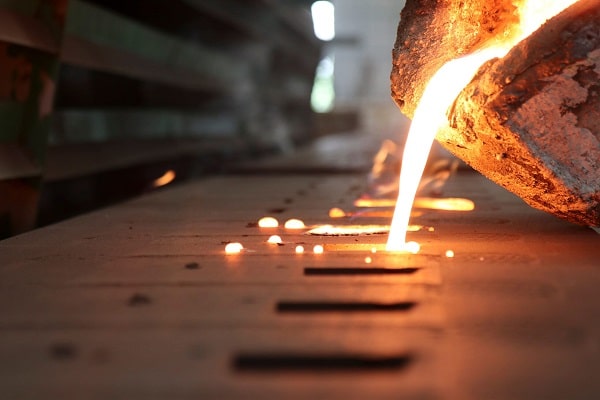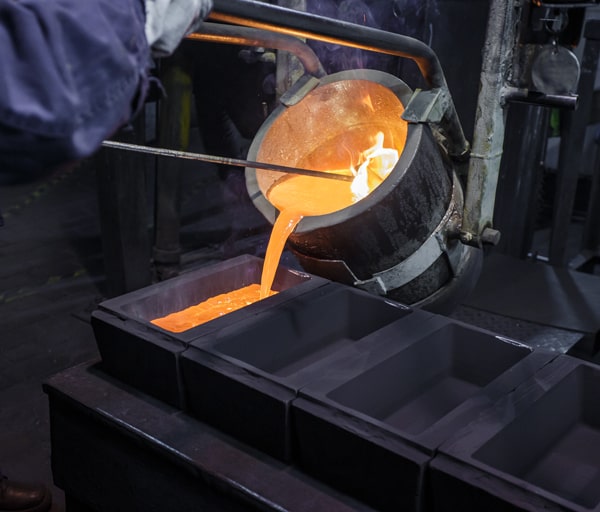Gilsonite in foundry
Uses of Gilsonite in Foundry
Gilsonite, uintaite, or asphaltum is a natural hydrocarbon that has numerous applications in various industries. One such industry where gilsonite is widely used in the foundry industry. Uintaite has unique features that make it an excellent choice for use in foundries. Let’s explore some of the gilsonite application in foundry and the benefits it provides.

Foundries are factories that are used to make metal parts by melting and pouring metal into molds. Foundries are an integral part of the manufacturing industry, and they have been around for centuries. Gilsonite is used in various casting industries as a carbonaceous additive due to its unique properties such as high carbon content, low ash content, and good fluidity. Some of the foundries where gilsonite can be used are as follows:
Steel foundries are facilities that produce steel castings. One of the gilsonite applications in foundry is that it’s used in steel casting as a carbon additive as it has a high carbon content and is easy to handle. Carbon is added to steel to improve its strength and durability and gilsonite is an excellent source of it. When added to the steel melt, gilsonite increases the carbon content, which improves the steel’s properties.

Brass and Bronze Foundries
Other facilities that use gilsonite in their production procedure are brass and bronze foundries. Like steel foundries, gilsonite is utilized as a carbon additive. Brass and bronze require carbon to improve their properties and gilsonite is the source of carbon that these foundries need to get the job done properly.
Iron Foundries
Gilsonite is used in iron foundries as a mold release agent. When molten iron is poured into a mold, it can stick to the mold surface, making it difficult to remove the casting. Uintaite is used as a mold release agent because it has outstanding lubricating properties. It forms a thin film on the mold surface, preventing the molten iron from sticking to it.
Aluminum Foundries
Gilsonite applications in foundry are uncountable. Aluminum foundries are another facilities that benefit from the valuable gilsonite. This material is used in aluminum foundries as a fluxing agent. Fluxing agents are added to the molten metal to remove impurities and improve the quality of the casting. Gilsonite is a great fluxing agent because it has a high carbon content and is rich in minerals that can react with the impurities in the molten metal.
The Benefits of Gilsonite
in Foundry
Gilsonite is a natural resinous rock with high carbon and bitumen content. In foundry applications, it is commonly used as a molding and core sand additive due to its unique physical and chemical properties. Some of the benefits of gilsonite applications in foundry include:
Improve Flowability
Gilsonite improves the flowability of the sand, making it easier to mold and shape.
Increase Strength
Uintaite strengthens the mold by enhancing cohesion and reducing the porosity of the sand.
Reduce Defects
One of the gilsonite applications in foundry is that it reduces the number of defects in the mold by providing better adhesion and preventing sand from sticking to the casting.
Increased Refractoriness
Gilsonite has a high melting point, which increases the refractoriness of the molding and core sand. This helps to withstand higher temperatures without breaking down.
increased Durability
Gilsonite application in foundry can improve the durability and strength of sand cores and molds. This can result in fewer defects and a longer lifespan of the molds.
Improved Release Properties
Gilsonite acts as a release agent, making it easier to remove the mold from the pattern. This reduces the likelihood of damage to the mold and improves the quality of the casting.
Reduce Production Time
Gilsonite speeds up the molding process by reducing the baking time required for the mold. Generally speaking, the use of uintaite in sand molds makes the casting process more efficient and produces higher-quality castings.
Reduced Veining
The veining is a common defect in foundry applications that occur when molten metal seeps into the molding sand. Gilsonite helps to reduce veining by forming a barrier layer between the mold and the metal, preventing metal penetration; that's why gilsonite applications in foundry are essential.
Reduced Smoke and Emissions
When sand cores and molds are exposed to high temperatures in the foundry, gases can be released, causing defects in the resulting casting. Gilsonite is a natural product that produces less smoke and emissions during the casting process compared to synthetic resins.
Gilsonite Applications
in Foundry
Gilsonite is used in the foundry as a binder for sand molds and cores. It improves the strength and durability of the molds and also reduces the risk of burn-on defects during the casting process. Gilsonite can also be used as a coating for metal castings to improve their appearance and protect them from corrosion. Additionally, it can be added to refractory materials to enhance their thermal conductivity and improve their resistance to high temperatures. In general, gilsonite applications in foundry are listed and explained below:

01
Gilsonite Works as a Binder
Sand binders are substances that are mixed with sand to create a mold in which metal is cast. Gilsonite is an excellent choice as a sand binder for several reasons. Firstly, it has a high softening point, which means that it can withstand high temperatures without melting or degrading. This property ensures that the mold can endure heat during the casting process without losing its shape. Secondly, Gilsonite is highly adhesive, which means that it can bind sand particles together, creating a strong and durable mold. It can also reduce the amount of resin required, resulting in cost savings.
02
Core-Making Process
Cores are used to create pockets or cavities in castings. Gilsonite is also used in core-making processes in foundries. Gilsonite applications in foundry and the core-making processes ensures a high-quality sand mixture that can withstand the heat of the casting process. Moreover, the use of Gilsonite in core-making ensures that the sand mixture hardens uniformly, leading to better core strength and accuracy.
03
Carbon Additive
More importantly, gilsonite is utilized as a carbon additive in foundries. The carbon content of gilsonite makes it an ideal choice to add to steel and iron alloys. The carbon additive increases the hardness and strength of the alloy, preventing it from cracking during the casting process. The carbon additive also helps to reduce the shrinkage of the alloy, which leads to better surface finishes in the final product.
04
Molding Process
Gilsonite can be used in molding sand to improve its properties, such as strength, durability, and resistance to heat and moisture.
05
Coatings
Gilsonite can also be utilized to create coatings that protect foundry molds and cores from damage caused by abrasion or corrosion.
06
Casting Release Agent
One more gilsonite application in foundry is that it can be used as a casting release agent, which prevents the castings from sticking to the mold or core.
07
Temperature Resistance
Uintaite can withstand high temperatures and can be used to produce foundry molds and cores that are capable of withstanding extreme temperatures.

